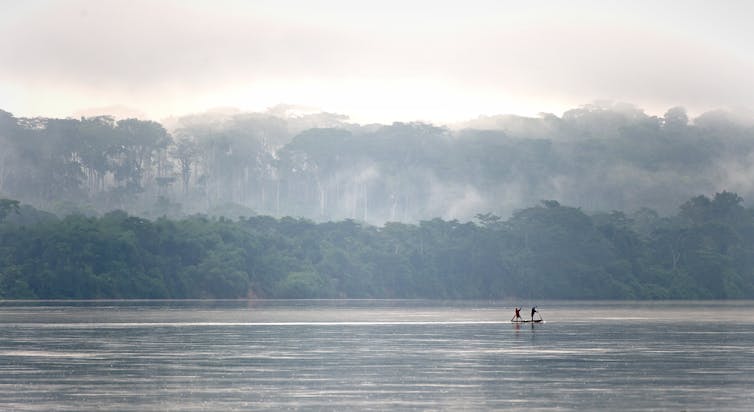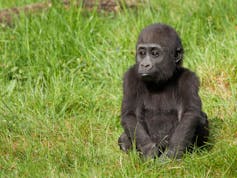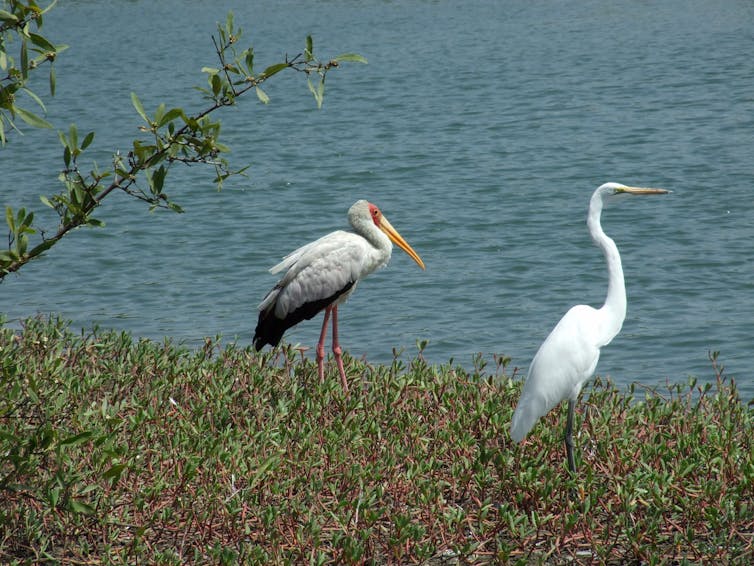The wave-like plateau of the Simien Mountains is exceptional and a feature of natural beauty at its best.

The Sangha River flows along the border of Cameroon, with the Central African Republic, and then the Republic of Congo. Shutterstock
Africa conjures up images of adventure, danger and to a certain degree romanticism. This is because it is one of the last untamed places on earth. Scenery from the rolling sand dunes of the Sahara to the lush forests of the Congo invites one to explore fascinating natural and culturally rich destinations.
Africa’s beauty spots should be on the bucket list of every traveller. For the adventurous, I have chosen seven lesser-known and out-of-the ordinary eco-destinations.
1. Mount Nimba
Mount Nimba is on the borders of Guinea, Liberia and Côte d’Ivoire. The slopes of the Mount Nimba Strict Nature Reserve are covered by dense forest. The foothills consist of grassy mountain pastures. It harbours rich flora and fauna, with native and threatened species like the viviparous toad and chimpanzees that use stones as tools.
The park is part of Guinea and Côte d’Ivoire. It is home to the most remarkable animal and plant populations on the continent. It is an isolated refuge covered with montane forests, which are more elevated than other forests, making the landscape of the Gulf of Guinea an exceptional ecological site.
Access is highly controlled and is only possible for organised groups with the proper permits.
2. The Sangha River
The Sangha Trinational is in the north-western Congo Basin where Cameroon, the Central African Republic and Congo meet.

Shutterstock
Much of the site is unaffected by human activity and features a broad range of humid tropical forest ecosystems with rich flora and fauna. This includes Nile crocodiles and the goliath tigerfish. Sangha is home to large populations of forest elephants, the critically endangered western lowland gorilla and endangered chimpanzee.

Shutterstock
3. Cape Verde
Cape Verde is a chain of islands off the coast of West Africa. The idyllic, uncrowded beaches and attractive and familiar Portuguese/Creole culture are big draws.

Reuters
It is a naturally beautiful country with landscapes ranging from volcanoes and mountains to lush valleys and barren, arid flatlands. This geographic diversity is ideal for trekkers and nature tourists. Nesting sea turtles and other wildlife bring another dimension to the country’s eco-tourism industry.
The tiny Spinguera Eco-Resort, on the island of Boa Vista, is the most overtly green spot in Cape Verde. The use of water and electricity is restricted, solar power is used to heat water and there are no TVs or air conditioners. Hiking, horseback riding, diving and bushwalking tours are all available.
4. The Gambia
The Gambia is surrounded by Senegal, with a narrow Atlantic coastline. It is known for its diverse ecosystems around the central Gambia River. Wildlife in the Kiang West National Park and Bao Bolong Wetland Reserve includes monkeys, hippos and rare birds.
The Gambia hosts Africa’s longest running chimpanzee rehabilitation project. Established in 1979, the project is now home to over 100 chimps. Wild chimps disappeared from the country in the early 1900s but four separate social groups can now be found on Baboon Islands where the project is based.
Gambia has taken steps to develop ecotourism such as Makasutu, a privately owned ecotourist reserve set within lush bush mangroves.
It was voted the best world eco-lodge by Britain’s Sunday Times.

Shutterstock
Visiting groups are deliberately kept small to reduce their impact on the forest’s fragile ecosystem. Solar power provides energy, and local people play a vital role in running the reserve.
Another lodge, the Sandele Eco Retreat was winner of The Guardian’s Ethical Travel Award.
5. Niger’s giant reserve
Niger, one of the poorest countries in the world, supports one of the largest conservation areas in Africa, the Air and Ténéré Natural Reserves.
The area considered a protected sanctuary makes up only one-sixth of the total reserve. It includes the volcanic rock mass of the Aïr, a small Sahelian pocket situated in the Saharan desert of Ténéré. The reserve boasts an outstanding variety of landscapes, plant species and wild animals. The region contains the blue marble mountains which are aesthetically stunning.
The Reserve of Aïr and Ténéré is the last bastion of Saharo-Sahlien wildlife in Niger. The isolation of the Aïr and the fact that very few people live there account for the survival of numerous species that have been eliminated from other regions in the Sahara and Sahel.
Habitats range from fixed dunes to stoney gravel desert, cliff valleys, canyons, high plateaus and water holes.
6. Salonga rain forests
Salonga National Park is Africa’s largest tropical rain forest reserve. The park, situated at the heart of the central basin of the Congo River, is isolated and accessible only by water. It contains the remarkable evolution of both species and communities in a forest area.
The park plays a vital role in climate regulation and the capture of carbon. It also hosts numerous threatened species like the pygmy chimpanzee, the bush elephant and the Congo peacock.

Shutterstock
Salonga National Park represents one of the very rare existing uniform environmental areas catering to specific biodiversity in central Africa. It is made up of vast marshland areas and practically inaccessible gallery forests. Some have never been explored and may still be considered as practically virgin.
7. Simien National Park, Ethiopia
The Simien National Park in northern Ethiopia is spectacular. Massive erosion over millions of years has created jagged mountain peaks, deep valleys and sharp precipices dropping some 1,500m.
The park holds global significance for biodiversity conservation because it is home to globally threatened species. These include, the iconic Walia ibex, a wild mountain goat found nowhere else in the world, the Gelada baboon and the Ethiopian wolf. The park’s spectacular landscape is part of the Simien Mountain range, which includes Ras Dejen, the highest point in Ethiopia.

Shutterstock
The wave-like plateau of the Simien Mountains is exceptional and a feature of natural beauty at its best. The spectacular scenery is considered to rival Colorado’s Grand Canyon.
Martinette Kruger, Professor of Tourism, North-West University and Armand Viljoen, PhD Candidate in Tourism Management, North-West University
This article is republished from The Conversation under a Creative Commons license. Read the original article.
For more news your way, download The Citizen’s app for iOS and Android.
Download our app




